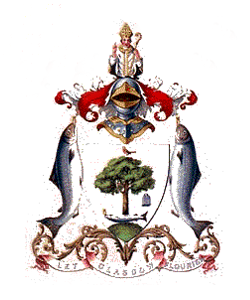Over the last few decades a return of the Atlantic salmon to the River Clyde, has shown an upward trend. So we decided to try and do a little research, to see if we could trace the history of Salmon fishing in the River Clyde. So where do we start? A major clue was in the city of Glasgow. The coat of arms supplied some vital clues… well it has got salmon within it.
Kids in Glasgow are taught the history behind this, but the history goes back many years further than the coat of arms. The Lord Lyon of Kings gave approval for a coat of arms in 1886. Many of the symbols had been on various seal of approvals before this, one being the Bishop of Glasgow’s own. Designed in 1271, it included a salmon with a ring in its mouth.
There is a small rhyme that kids learnt to do with the coat of arms:
“The tree that never grew. The bird that never flew. The fish that never swam. The bell that never rang”
The Tree
The Tree is now an oak, but apparently started as hazel, legend says St Mungo was in charge of the holy fire at St Serfs Monastery, and fell asleep. While sleeping, some boys put the fire out. It is said St Mungo broke frozen hazel branches, and prayed over them which made them burst into flames.
The Bird
St Serf tamed a wild robin, which St Mungo was blamed for killing. It is said he prayed over the dead bird and it came back to life.
The Fish
The coat of arms depicts a fish with a ring in its mouth. There are a few stories to this, but here is one version. The King of Strathclyde gave his wife a ring, and the Queen gave the ring to a knight, who lost it (there is a version of the story in which the King stole the ring while his wife slept and threw it in the Clyde). The King then demanded to see the ring, with the threat to kill the Queen if she could not produce it. The Knight confessed to St Mungo, who sent a monk out to catch a fish from the Clyde, and the ring was found when the fish was cut open.
The Bell
The first lord provost of Glasgow, John Stewart, left an endowment in 1450, so a St Mungo’s bell could be made and rang, so as the Citizens of Glasgow could pray for his soul. The bell was still ringing in 1578. In 1641, a new bell was purchased by the magistrates, and is now on display at the people’s palace museum. In 1631, another bell was made, for the Tron church, the bell was inscribed,”Lord Let Glasgow Flourish by the preaching of the word”. The coat of arms now says “LET GLASGOW FLOURISH”.
So this lead to some more research, we tried to trace Salmon fishing on the River Clyde, and here are some findings.
Glasgow is believed to have started at a crossing point on the River Clyde, over two thousand years ago, (Glasgow, Glascu the green hollow) there are a few other translations.
There are records that Govan was a farming and salmon village, and Salmon were netted from the 16th century, until the mid 19th century. There were many disputes over who had which netting rights and eventually stones were laid out, that marked the boundary of various fisheries. When Braehead was being built there was one stone believed to be the only one left, but although people were made aware of it, it was lost.
On record in 1595 at Rutherglen, there was an instruction letter from the presbytery to the bailiffs to stop the practice of salmon fishing, on a Sunday, by locals.
In the limited time we have had to research this we are struggling to find a lot more information, but were made aware of a salmon netting fishery at Crossford, and of some more within the Clyde and its tributaries.
Some members also made me aware that in the middle of the last century occasional salmon were seen or taken around Uddingston area. Another popular story was that in Glasgow at the fair when dry docks got emptied Salmon used to get trapped in the dry docks.
It is also on record of a court case in 1700`s of a prosecution of someone for obstructing the passage of salmon on the River Nethan, thus not allowing the netting of salmon further up.
In time we hope to research this further,and add more to this as we think it is of benefit and interest, to everyone.
Thanks to Ian Taylor for this article.

